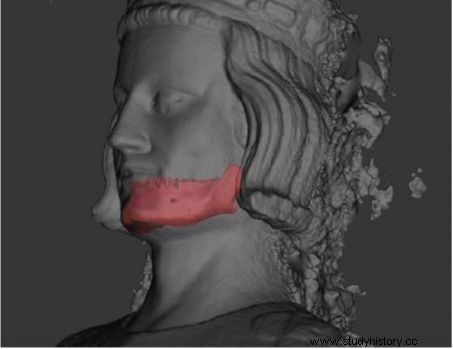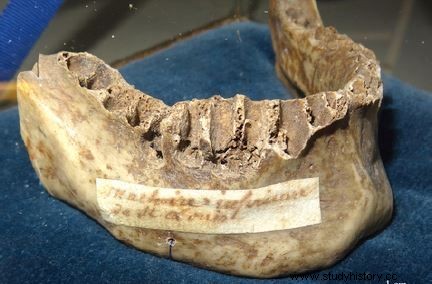It is not the plague that would have struck down Saint-Louis in front of Tunis during the VIIIth crusade in 1270. New analyzes carried out by a team of scientists point to other pathologies.

The death of Saint-Louis in Tunis, on August 25, 1270, during the VIIIth crusade. Miniature taken from the "Grandes Chroniques de France" by Jean Froissart (1337-1400). Condee Museum, Chantilly.
Neither dysentery, nor typhus... nor plague! Louis IX, King of France - better known as Saint-Louis since his canonization in 1297 - is said to have actually died of scurvy outside Tunis on August 25, 1270. Aged 56, he was then at the height of his his reign and had undertaken an eighth crusade at the head of nearly 15,000 men to try to save what could still be of the Latin States of the East. It was therefore in the shadow of the city walls, which he had not managed to bring down, that the king breathed his last due to this disease "due to acute vitamin C deficiency and which results, in its severe form, in loosening of the teeth, purulence of the gums, hemorrhages, then death t", according to the forensic scientist Philippe Charlier whose conclusions of the study, carried out in collaboration with a team of researchers from the University of Versailles-Saint-Quentin in Yvelines (UVSQ), have just been published in an article by the international journal Journal of Stomatology, Oral and Maxillofacial Surgery . This atypical expert, paleopathologist and now director of the research and education department at the Quai Branly museum in Paris, has made a specialty for several years of analyzing the bodies of famous historical figures... or at least what's left of it. And it is therefore a macroscopic study of the mandible of Saint-Louis - totally toothless -, saved in the Notre-Dame de Paris cathedral, which would have allowed the detection of this infectious pathology and, in this case, fatal. Before more detailed analyzes confirm it.

Superimposition of the scanned royal mandible from Notre-Dame de Paris, on a statue of Saint-Louis, dated from the 13th century and preserved in the church of Mainneville, in Normandy. Credits:Philippe Charlier et alii
"A direct examination of the mandible was carried out in Notre-Dame de Paris cathedral, followed by a CT scan and carbon-14 dating , explains Philippe Charlier. On the other hand, to carry out a complete anatomical comparison, the 3D superposition of the virtual double of the mandible was performed on a statue of Saint-Louis [contemporary of the sovereign, Editor's note], preserved in the church of Mainneville, in Normandy. All complemented by the study of all available historical and scientific literature, to better interpret the lesions detected on the relic ". In particular the biographies of Jean de Joinville (1224-1317), who had joined the king during the VII Crusade (1248-1254) and had already witnessed the devastating effects of the "disease of the Ost" on soldiers, responsible for a very large number of deaths due to deficient food. Jean de Joinville describes this syndrome as affecting the mouth with necrotizing gingivitis ("pourrie ès gums ") accompanied by severe joint pain in the legs ("Ost disease is in the mouth of the legs "), a fever, loss of muscle tone ("the flesh of our legs fell away completely, and the leather of our legs became scabby [strewn with stains, Ed]black and earth "), and nosebleeds. "To us who had this disease came rotten flesh and gums... no one escaped "). So many symptoms fully compatible with scurvy, which is also evidenced by the traces of lesions on the gums and the bone found on the mandible from Notre-Dame de Paris.

Jawbone attributed to King Louis IX, known as Saint-Louis, preserved in the Church of Notre-Dame-de-Paris. Credits:Philippe Charlier et alii
But how did this presumed jawbone from Saint-Louis come into the hands of Philippe Charlier? With what degree of certainty was he able to ascertain his sovereign origin? To understand, we must recall the tribulations of the body of the monarch during his repatriation to France. As was then the custom, his remains will first be "cooked" on site in a mixture of wine, water and spices, to facilitate its transport. The only way to avoid the degradation of the corpse during the long weeks required for its return, especially in summer! Archives thus indicate that after cooking, "his corpse was dissected and boiled to separate the flesh ". All the art of "mos Teutonicus ", the dismemberment of the body, so that each part joins a different place of burial in order to be venerated in various places of the kingdom where the cult of relics was then at its peak. Saint-Louis himself was a fervent follower , which is why he had the Sainte-Chapelle built in Paris to serve as a setting for the most important relics of the Christian world, which he bought at exorbitant prices:Christ's crown of thorns (now kept in the Treasury of the church of Notre-Dame-de-Paris) and a nail from the Passion. The burials of kings outside royal necropolises had become so common under the Capetians, that this practice was finally deemed detestable and condemned in 1299 by Pope Boniface VIII, by virtue of the decree Detestante feritatis , before it was brought up to date by his successor, Benoit XI.
In 1270, the bones of Saint-Louis were therefore brought back to France by his son Philippe III le Hardi, present at his side during the siege of Tunis. They will be deposited in the royal necropolis of the Basilica of St Denis (Seine Saint Denis), the burial place of the kings of France. The entrails will be kept in Sicily at his younger brother Charles of Anjou, in the Benedictine abbey of Monreale, near Palermo, before being partially moved to the cathedral of Versailles in the 19th century. "After his canonization in the 13th century, and the opening of the tomb, the skeletal remains were scattered ", writes Philippe Charlier. The reliquary of the Basilica of Saint-Denis was transported to Notre-Dame de Paris where it survived the destruction of the French Revolution, ensuring perfect traceability of the remains. "The parasitological analysis of a small biopsy of his viscera done previously showed that the king also suffered from a parasitic disease - urinary schistosomiasis -, which he could have contracted in Damietta, Egypt, during the VIIth crusade (1248-1258) ", he adds. A monarch already weakened during his participation in the VIIIth Crusade, whose retrospective diagnosis based on a paleopathological examination, seems to have highlighted the multiple deficiencies, probable causes of death.
